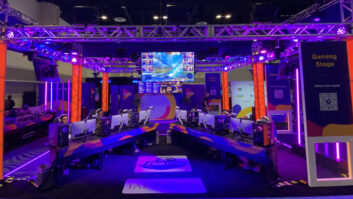LAS VEGAS, NV—InfoComm International called its 2014 conclave the largest ever, with some 37,000 AV professionals passing through the Las Vegas Convention Center in mid- June, with exhibits filling the Center Hall and overflowing into the North Hall. As visitors walked the exhibition floor, a few trends have become so prevalent that it’s not hard to see where at least the near-future is heading. The first, of course, is IP-enabled products. From loudspeakers to surge protectors, everything is trending towards the network and remote monitoring. This is important because it provides pro-AV integrators with a compelling and useful source of recurring revenue. It also introduces options for power management and energy efficiency.
Audio-Technica’s ATND971 networked microphone Second, aesthetics have come to the forefront in a big way. The days of hiding racks in closets are behind us—or can be if you want them to be. A huge emphasis is being placed on hidden, retractable cables and through-table and floor boxes—integrating with architecture and design is no longer an eyesore.

Third, all-inclusive solutions to conferencing and collaboration were everywhere at InfoComm. With the furniture, displays and cables already integrated into so many solutions, it is now easier than ever to bring these technologies to small businesses for which this technology would have previously been cost-prohibitive.
In a sneak preview during the show, InfoComm teased an upcoming paper called The 2014 Global AV Market Definition and Strategy Study (conducted by InfoComm by Acclaro Growth Partners and called the only worldwide study aimed at sizing the Commercial AV industry). The initial summary predicted growth in conferencing, signal management, AV acquisition and delivery equipment and streaming media at 11 percent compounded annually in demand for AV products and services between 2012 and 2016. The study finds that the audiovisual industry currently generates $92 billion a year.
“The AV industry is strong, thanks to a rebounding economy and a growing need for collaboration,” said David Labuskes, CTS, RCDD, executive director and CEO, InfoComm International. “However, growth is not universal across the world, and the strength of the burgeoning Asian market will overtake the North American market in size for the first time in 2016.”
Bose’s Accessory Cards AV applications such as displays, AV acquisition and delivery, projectors, signal management and processing and sound reinforcement are expected to drive future growth. The fastest growing product categories are control systems, software, AV acquisition and delivery and displays.

The corporate, venue/events and government/military markets are the three largest consumers of audiovisual products and services. However, hospitality is the fastest growing market for AV goods and services. The study, to be released in July, predicts a market size of $116 billion by 2016.
For many attendees, it’s all about the gear, and plenty of new products were on display in the exhibition halls. In the Net Gain category, Audinate announced the intriguing Via software app. With Via, without any Dante-enabled hardware, any computer (Mac or Windows) can be come a networked audio device, affording Dante network access to any connected or internal audio hardware, which can also be routed to and from any Dante connected device— for instance, hardware or another computer and devices connected to that computer. Such a hardware device might be the Audio-Technica ATND971 cardioid condenser boundary network microphone—the world’s first wired microphone to transmit both audio and control data over a Dante network. Developed with boardroom and meeting applications in mind, the ATND971 uses Ethernet for connectivity (PoE) and features a programmable switch that could be used for networked tasks like lighting or video camera control.
DiGiCo’s D2-Rack Filed under Can We Talk Here?, are devices like the new Bose ControlSpace accessory cards, giving the ESP-00 II engineered sound process new mic/line input, line output and GPIO control capabilities. For its PowerMatch configurable power amplifiers, as a companion to network I/O options, Bose introduced the AES3 8-Channel Input Card to accommodate direct inputs from consoles— a response to user requests. At InfoComm for the first time under the banner of its new USA and Canadian subsidiary (run by Paul Morini), console maker CADAC debuted new networked interface components— the CDC MC Router, CDC MC MADI Network Bridge and CDC MC Dante Network Bridge. The MC stands for MegaCOMMS, CADAC’s system network, which allows for up to 3,072 channels of 96 kHz/24-bit audio with latency management for time-aligned signal distribution at less than .4 ms from stage inputs to stage outputs. Multiple consoles and stage boxes can be connected with Mega- COMMS, and now with the new interfaces, MADI and Dante networks can be incorporated.

While talking interfaces, DiGi- Co repeated a demo from ProLight + Sound in conjunction with Clear- Com, showing direct console support via an Optocore audio I/O and Broaman video interface (remote Webby, live from across the hall!). DiGiCo also officially launched the D2-Rack that was previewed earlier this year. Connected via either BNC- or Cat 5-transmitted MADI, the D2-Rack allows users to take advantage of the full 96 kHz operating potential of the SD8, SD9 and SD11 consoles (with no loss of channel count) and with the latest converters employed, system latency is just over 1 ms. Two D2-Rack versions are available: 48-mic ins by 16 line outs with 16 optional outputs in analog, AES or Aviom formats, or 24-mic ins plus 24-AES ins with the same output complement.
From the I Know You Can Hear Me Now department, Electro-Voice previewed its next generation X-Line loudspeakers—the compact X1 and higher performance X2, both featuring EV Hydra wave-shaping devices (for improved HF performance and box-to-box coupling optimization), integrated rigging and EV’s proprietary FIR-Drive DSP control of coverage and frequency performance. Also in the loudspeaker arena, JBL extended its updated EON series with the EON610 and EON612 models, both two-way with 10- and 12-inch woofers, respectively. Both feature 1000 W of power and benefit from JBL’s ongoing HF waveguide research.
Shure’s QLX-D Digital Wireless microphone system On the Down Low, loudspeaker introductions included multiple subwoofer innovations. Adamson Systems debuted the E219, an Energia family extension featuring two “lightweight, long-excursion, 19-inch SD19 Kevlar/ Neodymium drivers with dual 5-inch voice coils.” Can you say, “Woof?” The al family from Vue Audiotechnik also has a new LF sibling—the al-4 Flyable Isobaric Subwoofer, which features dual 15-inch subs with four-inch voice coils. The al-4-sb can be suspended above or behind al-4 line arrays, and includes a flyable end-fire grid for directional control. It can also be quickly rigged in a flexible range of groundstack applications. Per Vue, the “isobaric” cabinet design reduces both size and distortion. For the great outdoors, the all-weather specialists at One Systems have introduced the small footprint 118IM-Sub featuring an 18-inch transducer with One Systems’ patented Inside/Only (I/O) voice coil design. IEC and Mil Spec standards for severe and prolonged weather exposure are met by the sub, and it can be hung with internal rigging or be pole-mounted.

Also designed to handle the weather is the 18iD extended low frequency driver shown by 18 Sound. The subwoofer component was reportedly engineered for optimal performance with Class D and similar amplifier topologies, with high power handling and low distortion. As it was the company’s first appearance at a U.S. trade show, Jeffrey Cox, head of business development, marketing and sales for the Italian loudspeaker component manufacturer introduced key staff, including CEO Antonia Fiaccadori and industry veteran Steve Hutt as the new manager of R&D. Earlier this year, 18 Sound announced the shipping of its NCX neodymium magnet coaxial speakers in 12-inch and 15-inch models for reflex enclosures and stage monitor use, and also on display at InfoComm were other components from 18 Sound’s catalog.
Audix’ M3 Tri-Element Ceiling Microphone. To facilitate Cutting The Cord, Shure is now offering a cost-effective digital wireless package: the QLX-D system. Shure promises “exceptional” wireless performance with 24-bit audio resolution and a wide, flat frequency response alongside advanced features such as network control, compatibility with the company’s “intelligent” rechargeable battery technology, andautomatic channel scan in IR sync between receiver and transmitter. CAD Audio, too, has a new wireless package—the 1600 Series. The series includes the TX1600 handheld transmitter and the WX1619 bodypack system with a TX 1610 body pack transmitter. The WX1619 also includes CAD’s Equitek E19 earworn condenser mic, a cardioid lavalier mic and a guitar cable. The transmitters and the WX1600 receiver are all 100-channel frequency agile across the UHF band, with automatic channel scanning and selection and true diversity operation.

For those who prefer to Get Wired, mic manufacturer Audix has released a new conference room mic, the M3 Tri-Element Ceiling Microphone. Audix says the M3 is the only multi-element mic available that is fully balanced below the ceiling, with a UL rated plenum connection box above the ceiling. The low-impedance, balanced output reduces cross talk and interference if long cable runs are required (and RF shielding is integral). The gold-sputtered capsules and housing are tailored for voice clarity. Audix says the mic was developed in response to requests from users of its other ceiling mics for a multiple capsule version
Mixing It Up was Allen & Heath, extending its Qu series with the Qu- 32, a 32-fader, 38-in/28-out digital mixer. The Qu-32 shares Qu family traits such as total recall of settings (including faders and digitally controlled preamps), the Qu-Drive integrated multi-track recorder, the dSNAKE for remote I/O and personal monitoring, multi-channel USB streaming, the Qu-Pad control app, and the iLive FX Library. Its 7-inch touchscreen is larger than its forebears and the Qu-32 houses 33 motorized faders. Intended primarily for stage use, a 16-mic in x 8-line out portable audio rack compatible with A&H’s Qu and GLD range consoles was also introduced—the AB168. Taking the digital console more virtual, the Waves Audio and Crest Audio collaboration continues on the Tactus Digital Mixing System. The system includes a customizable touch-screen control paradigm to manipulate the Waves eMotion Mixer for SoundGrid. Crest’s new contributions are the Tactus FOH audio processing core (which employes the Waves SoundGrid DSP and networking platform), the Tactus Stage (a 32- in by 16-out stage box) and the Tactus Control (hardware control unit).
Finally, Amping Up was Harman’s Crown Audio, which introduced its XLC2800 and XLC2500 power amplifiers, designed for installed sound use. The Crown DriveCore technology-equipped Class D amps offer a cost-effective, application-specific feature set, sans network I/O and other features not necessary for the intended application. Into a four ohm load, the amps offer 775 W and 500 W per channel (respectively) and 2400 W and 1550 W bridged.
InfoComm
infocommshow.org







